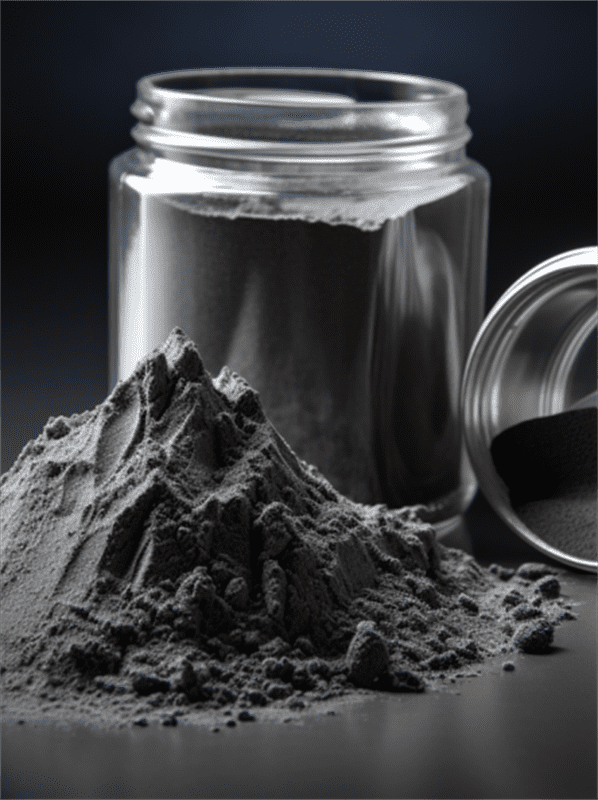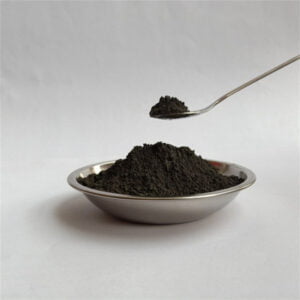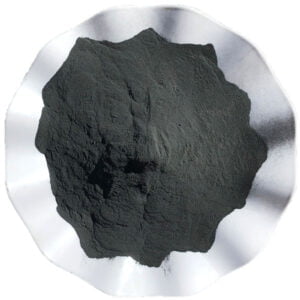Injection Mouldable Powder
Table of Contents
Injection mouldable powder refers to a type of feedstock material used in powder injection moulding, an industrial manufacturing process to produce complex and high-precision metal parts. This powder is a mixture of fine metal powders and polymer binders which can be injection moulded into complex net-shape parts in high volume.
Advantages of Using Injection Mouldable Powder
| Advantage | Description | Benefit |
|---|---|---|
| Complex Geometries: IMP allows for the creation of intricate shapes with fine features that are difficult or impossible to achieve with traditional injection molding techniques. This design freedom opens doors for innovative components in various industries. | Unlike traditional molding materials like molten plastics, IMP utilizes a binder system that holds the powder particles together during the molding process. This enables the creation of parts with internal channels, undercuts, and other complex geometries. | |
| Material Efficiency: IMP promotes near-net-shape manufacturing, minimizing material waste compared to subtractive techniques like machining. This is particularly beneficial for expensive or high-performance materials. | The precise control over powder distribution during injection molding minimizes excess material usage. Additionally, unlike traditional processes that generate scrap parts during trial runs, IMP allows for faster design iterations with minimal material waste. | |
| Broad Material Selection: IMP offers a wider range of material options compared to traditional injection molding. This versatility allows for the creation of parts with specific properties tailored to the application. | Beyond standard polymers used in injection molding, IMP can utilize metal powders, ceramics, and even composite materials. This opens doors for the creation of parts with unique combinations of strength, conductivity, or biocompatibility. | |
| High-Performance Parts: The ability to utilize metal and ceramic powders in IMP enables the production of high-performance parts with exceptional strength, heat resistance, or wear properties. | Metal injection molded (MIM) components can achieve mechanical properties comparable to wrought (bulk) metals, making them suitable for demanding applications. Similarly, ceramic IMP parts offer excellent wear resistance and high-temperature performance. | |
| Mass Production Potential: While initially used for prototyping, IMP technology has matured to enable cost-effective mass production of complex parts. | The high degree of automation achievable in IMP processes allows for efficient production of large quantities of parts with consistent quality. This makes it a viable option for high-volume applications. | |
| Improved Surface Finish: Compared to traditional metal casting techniques, IMP can sometimes achieve a smoother surface finish on the final parts. | The use of fine powders and the controlled molding process can minimize surface imperfections, potentially reducing the need for extensive post-processing steps like polishing. |

Composition of Injection Mouldable Powder
| Component | Description | Function |
|---|---|---|
| Base Powders | These constitute the primary functional material of the final part and can be categorized into three main types: Metal Powders: Finely divided metallic particles of various alloys, such as stainless steel, tool steel, or superalloys. Ceramic Powders: Ceramic materials like alumina, zirconia, or silicon nitride in powder form. Polymer Powders: Thermoplastic polymers commonly used in injection molding, such as nylon or polypropylene. | The choice of base powder determines the final properties of the molded part, such as strength, wear resistance, or thermal performance. |
| Binder System | This is a crucial component that acts as a temporary glue, holding the base powder particles together during the molding process. The binder system typically consists of: Thermoplastic Polymer: A thermoplastic resin that melts during the injection molding stage, enabling flowability and adhesion with the base powder. * Waxes or Additives: These can enhance flow properties, improve debinding efficiency, or aid in powder dispersion within the binder. | The binder system ensures the powder behaves like a moldable feedstock during injection and allows for the creation of complex shapes. |
| Pore Formers | These are optional additives that create temporary pores within the molded part. They can be: * Organic Materials: These burn out during debinding, leaving behind a network of pores that facilitate the removal of the binder system. * Chemical Leaching Agents: These dissolve in a specific solvent during a post-processing step, creating a controlled pore structure. | Pore formers enable the creation of porous structures within the final part, which can be beneficial for applications like filters or bone implants. |
Characteristics of Metal Powders Used
| Characteristic | Description | Importance in MIM |
|---|---|---|
| Particle Size & Distribution | The size and distribution of the metal powder particles significantly impact the following aspects of MIM: Mold Filling & Green Strength: Finer powders generally offer better packing density and can improve mold filling during injection. However, excessively fine particles can hinder flowability and lead to challenges during processing. A narrow particle size distribution ensures consistent packing and minimizes voids within the molded part, contributing to good green strength (strength of the part before sintering). Sintering Behavior & Final Properties: Particle size influences the sintering process, where particles bond together to form a solid structure. Powders with a wider size distribution can lead to inhomogeneous sintering and potentially affect the final mechanical properties of the part. | Careful selection of particle size and distribution is crucial for achieving good mold filling, green strength, and optimal performance in the final sintered component. |
| Particle Morphology | This refers to the shape of the metal powder particles. Ideally, MIM processes favor powders with spherical or near-spherical morphologies. | Spherical particles flow more readily, improving mold filling and packing density. Irregularly shaped particles can create voids and hinder flowability, potentially leading to defects in the molded part. |
| Apparent & Tap Density | These properties represent the bulk density of the powder under different conditions. Apparent Density: This refers to the density of the powder at rest, considering the spaces between particles. Tap Density: This reflects a denser state achieved through a standardized tapping process. | Higher tap density is generally desirable in MIM for efficient material utilization and good dimensional accuracy in the final part. It also contributes to improved packing during molding and minimizes shrinkage during sintering. |
| Chemical Composition | The specific elements or alloys used in the metal powder determine the final properties of the sintered part. | The choice of metal powder composition allows for tailoring properties like strength, corrosion resistance, or wear resistance to meet the specific application requirements. MIM can utilize various metal alloys, including stainless steel, tool steel, and even high-performance alloys like Inconel. |
| Flowability | This refers to the ease with which the powder flows under gravity or applied forces. | Good flowability is essential for uniform powder distribution during injection molding. Powders with poor flowability can lead to inconsistencies in packing density and potential defects in the final part. |
Standards for Metal Powders
Metal powders used must meet composition and grain standards:
| Standard Body | Standard | Description | Importance in IMP |
|---|---|---|---|
| ASTM International (ASTM) | ASTM B930 – Standard Guide for Powder Characterization of Metal Injection Molding (MIM) Feedstock | This standard outlines various test methods for characterizing the properties of metal powders used in MIM. | Provides a framework for evaluating factors like particle size distribution, morphology, flowability, and apparent density. This ensures consistency and quality control in the metal powders used for IMP applications. |
| ** | ** | * ASTM B783 – Standard Specification for Stainless Steel Powders for Metal Injection Molding (MIM) Applications | This standard defines specific requirements for the chemical composition, particle size distribution, and flowability of stainless steel powders used in MIM. |
| ** | ** | * ASTM D4000 – Standard Classification System for Specifying Plastic Materials | While not exclusive to IMP, this standard provides a classification system for various types of plastic materials, including those potentially used as binders in IMP feedstock. |
| International Organization for Standardization (ISO) | * ISO 3095 – Metallic powders – Determination of flow rate by means of a Hall flowmeter | This standard specifies a method for measuring the flowability of metallic powders using a Hall flowmeter. | Provides a standardized approach for assessing flowability, a critical characteristic for achieving good mold filling and consistent part quality in IMP. |
| ** | ** | * ISO 4497 – Plastics – Determination of the melt flow rate (MFR) and melt volume-flow rate (MVR) of thermoplastics | This standard outlines a method for measuring the melt flow rate (MFR) of thermoplastic materials, which can be relevant for the binder component in IMP feedstock. |
Steps in Manufacturing Process
The manufacturing process consists for the following key steps:
| Step | Description | Importance |
|---|---|---|
| 1. Powder Preparation & Mixing | The base powder (metal, ceramic, or polymer) is carefully selected and pretreated based on the desired final properties. Additives like pore formers or lubricants may be included. The powder is then precisely weighed and blended with the binder system to form a homogeneous feedstock. | This step establishes the foundation for the final part’s properties. Careful selection and accurate mixing ensure consistent material behavior during processing. |
| 2. Injection Molding | The prepared IMP feedstock is heated to a semi-molten state and injected into a closed mold cavity under high pressure. The mold replicates the desired shape of the final part. | This stage defines the part’s geometry. Consistent flow and pressure during injection are crucial for achieving accurate part dimensions and minimal defects. |
| 3. Debinding | The molded part, also called the “green part,” undergoes a debinding process to remove the binder system. This can be achieved through: * Solvent Debinding: The part is submerged in a solvent that dissolves the binder, leaving behind the powder structure. * Thermal Debinding: The part is exposed to a controlled heating cycle, where the binder thermally decomposes and escapes as gas. | Effective debinding is critical for achieving the final desired shape and porosity without damaging the delicate powder structure. |
| 4. Sintering | The debindered part is subjected to high temperatures in a controlled atmosphere (often under vacuum or inert gas). This process promotes diffusion and bonding between the powder particles, resulting in a solid and near-net-shape component. | Sintering dictates the final mechanical properties of the part, such as strength, density, and dimensional stability. Precise temperature control and atmosphere management are essential. |
| 5. Post-Processing | Depending on the application requirements, the sintered part may undergo additional finishing steps such as: * Machining or Grinding: For achieving precise dimensional tolerances or surface finishes. * Heat Treatment: To enhance specific mechanical properties like strength or hardness. * Coating or Infiltration: To improve surface properties like wear resistance or corrosion resistance. | Post-processing treatments can further enhance the functionality and aesthetics of the final IMP part. |
Applications of Injection Moulded Parts
Injection mouldable powder can be used to manufacture various intricate and high-precision parts across industries:
| Industry | Application Examples | Benefit of Injection Molding |
|---|---|---|
| Automotive | Interior components ( dashboards, door panels, consoles) Under-the-hood parts (fan shrouds, intake manifolds) Functional components (gears, sprockets) | High-volume production of complex shapes with precise features. Lightweight parts for improved fuel efficiency. Wide range of material options for various performance needs (durability, heat resistance). |
| Consumer Electronics | Electronic housings (phones, laptops, tablets) Connectors and buttons Internal components (brackets, gears) | Mass production of intricate parts with high dimensional accuracy. Smooth surface finishes for aesthetics and user comfort. Variety of colors and textures achievable through material selection and molding techniques. |
| Medical Devices | Surgical instruments (handles, grips) Prosthetic components (knee joints, dental implants) Disposable medical components (syringes, vials) | Sterilizable materials for hygiene and safety. Biocompatible materials for use in the human body (certain polymers and metal alloys). Complex geometries for precise functionality in medical applications. |
| Aerospace & Defense | Aircraft components (ducts, landing gear parts) Satellite components (brackets, housings) Defense equipment (helmets, weapon components) | Lightweight and high-strength materials for weight reduction in aerospace applications. Flame-retardant or heat-resistant materials for specific requirements. Durable parts for harsh environments and demanding operational conditions. |
| Consumer Goods | Toys and games Appliances (housings, knobs, dials) Sporting goods (helmets, bicycle parts) | Cost-effective production for high-volume consumer products. Wide variety of colors and finishes for visual appeal. Durable and functional parts for everyday use. |
Advantages of Injection Molding for Part Manufacturing
| Advantage | Description | Benefit |
|---|---|---|
| High-Volume Production: Injection molding excels at producing large quantities of identical parts efficiently. The automation capabilities and rapid cycle times allow for cost-effective mass production. | This is particularly advantageous for products requiring millions of units, such as consumer electronics or automotive components. Consistent quality and repeatability are ensured throughout the production run. | |
| Design Flexibility: Injection molding can accommodate a wide range of geometric complexities, including intricate shapes, thin walls, and internal features. This design freedom enables the creation of functional and innovative parts. | Unlike some subtractive manufacturing methods, injection molding is not limited by tool geometry. Undercuts, channels, and other complex features can be directly molded into the part. | |
| Dimensional Accuracy & Repeatability: The precise control over mold design and injection parameters allows for consistent and accurate part dimensions across high production volumes. | This minimizes the need for post-processing steps for dimensional correction and ensures interchangeable parts for assembly. Repeatability is crucial for maintaining consistent product quality and functionality. | |
| Wide Material Selection: A vast array of materials can be used in injection molding, including thermoplastics, thermosets, elastomers, and even some metal alloys (through Metal Injection Molding – MIM). | This versatility allows for selecting the optimal material based on the desired properties like strength, heat resistance, chemical resistance, or flexibility. | |
| Surface Finish & Aesthetics: Injection molding can produce parts with smooth and high-quality surface finishes, often eliminating the need for extensive post-processing steps like polishing. Additionally, various colorants and textures can be incorporated during molding. | This contributes to the visual appeal and functionality of the final product. Smooth surfaces can be essential for hygiene in medical devices or for easy cleaning in consumer goods. | |
| Material Efficiency: Injection molding promotes near-net-shape manufacturing, minimizing material waste compared to subtractive techniques like machining. Excess material, called sprue and runners, can often be recycled and reused in subsequent production runs. | This is beneficial from a cost and sustainability perspective. Minimizing waste also reduces the environmental impact of the manufacturing process. | |
| Automation Potential: The injection molding process can be highly automated, with minimal human intervention required for operation. This allows for consistent production quality and reduces labor costs. | Automation is particularly advantageous for high-volume production runs and ensures consistent product quality regardless of operator skill level. |
Limitations of Manufacturing Process
There are some limitations as well:
- Part weight limited to < 400 g
- Wall thickness > 0.4 mm
- Assemblies needed for complex geometries
- Expensive tooling for molds
- Dimensional changes during sintering
Global Suppliers of Feedstock Material
Many international companies supply ready feedstock material for injection molding:
| Company | Location | Materials |
|---|---|---|
| BASF | Germany | 316L stainless steel, titanium alloys |
| Sandvik | Sweden | Stainless steels, tool steels |
| GKN | UK | Aluminum & magnesium alloys |
| Rio Tinto | Australia | Metal and ceramic injected mixes |
Indicative Pricing
| Material | Price Range |
|---|---|
| Stainless Steel | $50-70 per kg |
| Tool Steel | $45-65 per kg |
| Tungsten Heavy Alloy | $130-170 per kg |
Pricing depends on order volumes, customization needs, and economic factors.
Pros and Cons of Using Injection Mouldable Powders
| Advantages | Disadvantages |
|---|---|
| Intricate and complex shapes | Limited size and weight |
| Closer tolerances | Expensive tools and equipment |
| Fine surface finish | Dimensional changes during sintering |
| Range of materials | Post-processing often needed |
| High production, low cost per part | Brittle materials tend to crack |
| Reduced waste | Restricts choice of material |

FAQ
Q: What is the typical composition of injection mouldable powders?
A: They contain 80-90% metal powder, 8-20% binder, and 1-2% lubricants by weight. Common binders are wax, PP, PE, and PEG.
Q: What size range of powders is used?
A: Powders between 1-20 microns are used. Finer powder improves density but can be prone to agglomeration.
Q: How much shrinkage occurs during sintering?
A: Up to 20% linear shrinkage of parts occurs during liquid phase sintering. Allowances must be made in tool design.
Q: What causes cracks in sintered metal injection molded parts?
A: Non-uniform heating in ovens, use of rapid cooling after sintering, poor powder mixing, and choice of brittle alloys.
Q: What materials options exist for injection moldable powders?
A: Stainless steels, tool steels, tungsten heavy alloys, copper alloys, titanium & titanium alloys amongst others.
Share On
MET3DP Technology Co., LTD is a leading provider of additive manufacturing solutions headquartered in Qingdao, China. Our company specializes in 3D printing equipment and high-performance metal powders for industrial applications.
Inquiry to get best price and customized Solution for your business!
Related Articles
About Met3DP
Recent Update
Our Product
CONTACT US
Any questions? Send us message now! We’ll serve your request with a whole team after receiving your message.

Metal Powders for 3D Printing and Additive Manufacturing
COMPANY
PRODUCT
cONTACT INFO
- Qingdao City, Shandong, China
- [email protected]
- [email protected]
- +86 19116340731

















